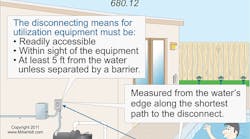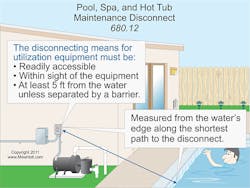Stumped By the Code? Requirements for Installing Maintenance Disconnect at a Pool, Acceptable Wiring Methods for Class I Locations, and More
All questions and answers are based on the 2011 NEC.
Q. What is the NEC requirement for a maintenance disconnect at a pool, outdoor spa, or outdoor hot tub?
A. A maintenance disconnecting means is required for the permanently installed pool, storable pool, outdoor spa, outdoor hot tub, or fountain equipment, other than lighting for these water bodies [680.12]. The maintenance disconnecting means must be readily accessible and located within sight and at least 5 ft from the permanently installed pool, storable pool, outdoor spa, outdoor hot tub, or fountain equipment, unless separated from the open water by a permanently installed barrier that provides a 5-ft reach path or greater. This horizontal distance is measured from the water’s edge along the shortest path required to reach the disconnecting means, as shown in the Figure. According to Art. 100, “within sight” means it’s visible and not more than 50 ft from one to the other.
Q. What are the acceptable wiring methods for Class I locations according to the NEC?
A. Only the following wiring methods are permitted within a Class I, Div. 1 location [501.10(A)(1)]:
- Threaded rigid metal conduit or intermediate metal conduit with explosionproof fittings [501.10(A)(1)(a)].
- MI cable terminated with fittings listed for the location [501.10(A)(1)(b)].
- In industrial establishments with restricted public access where only qualified persons will service the installation,
MC-HL cable listed for use in Class I, Zone 1, or Div. 1 locations, with a gas/vaportight continuous corrugated metallic sheath, an overall jacket of suitable polymeric material, a separate equipment grounding conductor(s) in accordance with 250.122, and terminated with fittings listed for the application. Such cable must comply with Part II of Art. 330 [501.10(A)(1)(c)]. Article 100 defines a “Qualified Person” as one who has skills and knowledge related to the construction and operation of the equipment and has received safety training on the hazards involved.
- In industrial establishments with restricted public access where only qualified persons will service the installation, ITC-HL cable terminated with fittings listed for the location [501.10(A)(1)(d)].
- Explosionproof flexible metal connection listed for the location are permitted in a Class I, Div. 1 location when necessary for vibration, movement, or flexible cords for difficult bends in accordance with 501.140, if terminated with cord connectors listed for the location [501.10(A)(2)].
- Boxes and fittings must be approved by the AHJ for Class I, Div. 1 locations [501.10(A)(3)].
Only the following wiring methods are permitted within a Class I, Div. 2 location [501.10(B)]:
- Wiring methods permitted in Class I, Div. 1 locations by 501.10(A) [501.10(B)(1)].
- Enclosed gasketed busways and enclosed gasketed wireways.
- PLTC and Type PLTC-ER cable terminated with listed fittings in accordance with Art. 725.
- ITC and ITC-ER cable terminated with listed fittings as permitted in 727.4.
- Types MC, MV, or TC cables, including installation in cable tray systems and terminated with listed fittings.
- Where metallic conduit doesn’t provide sufficient corrosion resistance, reinforced thermosetting resin conduit and Schedule 80 PVC conduit can be used, but only in industrial establishments where maintenance and supervision ensure only qualified persons service the installation.
If flexibility is necessary, the following wiring methods are permitted [501.10(B)(2)]:
- Listed flexible metal fittings.
- Flexible metal conduit with listed fittings.
- Liquidtight flexible metal conduit with listed fittings.
- Liquidtight flexible nonmetallic conduit with listed fittings.
- Flexible cords listed for extra-hard usage, containing an equipment grounding conductor, and terminated with listed fittings.
Comment: See the definition of “Grounding Conductor, Equipment” in Art. 100. If flexible cords are used, they must comply with 501.140.
501.10(B) Informational Note: See 501.30(B) for equipment grounding requirements where flexible conduit is used.
General-purpose enclosures and fittings are permitted, according to 501.10(B)(4), unless the enclosure contains make-and-break contacts for meters, instruments, and relays [501.105(B)(1)], switches, circuit breakers, or motor controllers [501.115(B)(1)], signaling, alarm, remote-control, and communications systems [501.150(B)]. See the definition of “Controller” in Art. 100.
Q. Does the Code require the bonding of metal skin on wooden frame “pole buildings?”
A. Exposed structural metal that forms a metal building frame that’s likely to become energized must be bonded to the [250.104(C)]:
- Service equipment enclosure,
- Service neutral conductor,
- Building/structure disconnecting means for buildings or structures supplied by a feeder or branch circuit,
- Grounding electrode conductor if of sufficient size, or
- Grounding electrode system.
This rule doesn’t require the bonding of sheet metal framing members (studs) or the metal skin of a wood frame building.
The bonding jumper must be sized in accordance with Table 250.66, based on the area of the ungrounded supply conductors. The bonding jumper must be copper where within 18 in. of the earth [250.64(A)], securely fastened to the surface on which it’s carried [250.64(B)], and adequately protected if exposed to physical damage [250.64(B)]. In addition, all points of attachment must be accessible, except as permitted in 250.68(A).
Section 250.24(C)(3) addresses bonding of conductive materials in more general terms. Conductive materials, such as metal water piping systems, metal sprinkler piping, metal gas piping, and other metal-piping systems as well as exposed structural steel members likely to become energized, must be bonded together in a manner that creates a low-impedance fault current path that’s capable of carrying the maximum fault current likely to be imposed on it [250.4(C)(3)].
The phrase “likely to become energized” is subject to interpretation by the AHJ.
Q. What are the requirements for SE cable if used for feeders and branch circuits, and what conductor temperature rating is used when sizing the SE cable?
A. Type SE service-entrance cable is permitted for branch circuits and feeders where the circuit conductors are insulated [338.10(B)(1)]. SE cable is permitted for branch circuits and feeders if the insulated conductors are used for circuit wiring, and the uninsulated conductor is only used for equipment grounding purposes [338.10(B)(2)].
Exception: In existing installations, uninsulated conductors may be used for the neutral conductor if the uninsulated neutral conductor of the cable originates in service equipment.
SE cable must not be subjected to conductor temperatures exceeding its insulation rating [338.10(B)(3)].
SE cable used for branch circuits or feeders must comply with (a) and (b) [338.10(B)(4)].
SE cable used for interior branch circuit or feeder wiring must be installed in accordance with the same requirements as Type NM Cable — Art. 334, excluding 334.80.
The maximum conductor temperature rating can be used [310.15(B)(2)] for ampacity adjustment and correction purposes. But when installed in thermal insulation, the conductors must be sized in accordance with Table 310.15(B)(16) 60°C rated conductor column.
Caution: Underground service-entrance cable (USE) is not permitted for interior wiring, because it does not have a flame-retardant insulation. It would only be permitted in interior wiring when dual-listed as wire type in accordance with Table 310.104, such as RHW.
In exterior applications, the cable must be supported in accordance with 334.30 and — where run underground — the cable must comply with Part II of Art. 340.
Q. What is the NEC requirement for an emergency shutoff switch for a spa or hot tub?
A. In other than a single-family dwelling, a clearly labeled emergency spa or hot tub water recirculation and jet system shutoff must be supplied. The emergency shutoff must be readily accessible to the users and located not less than 5 ft away, but adjacent to and within sight of the spa or hot tub [680.41].
Either the maintenance disconnecting means required by 680.12 or a pushbutton that controls a relay located in accordance with this section can be used to meet the emergency shutoff requirement. The purpose of the emergency shutoff is to protect users. Deaths and injuries have occurred in less than 3 ft of water because individuals became stuck to the water intake opening. This requirement applies to spas and hot tubs installed indoors as well as outdoors.
Q. What is the Code rule regarding tap conductors to a recessed luminaire?
A. Fixture wires installed in accordance with Art. 402 and protected against overcurrent in accordance with 240.5(B)(2), are permitted to run from the luminaire to an outlet box located at least 1 ft away from the luminaire, as long as the conductors aren’t more than 6 ft long [410.117(C)].





